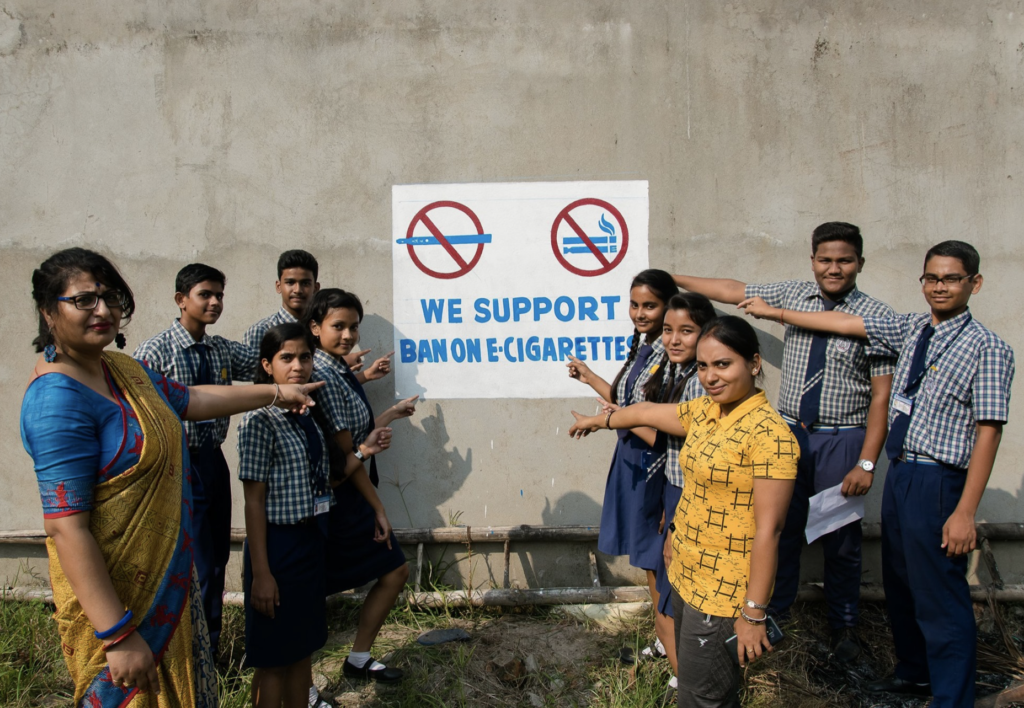
A hallmark of Vital Strategies’ approach is that we work closely with governments in various countries, especially low- and middle-income countries, to help them build capacity in communication as part of their public health programs. Recently, our team in India completed message testing for a mass media campaign on the harms of e-cigarettes. Vaishakhi Mallik our Associate Director for South Asia, explains the importance of testing messages before running new campaigns.
What is message testing?
A significant part of our evidence-based approach to strategic communication is pretesting communication campaigns, or in other words, conducting message testing studies. This is a quantitative and qualitative research method where focus group discussions are held with members of the target audience, to assess whether the concepts meet campaign objectives and to make sure that campaign messages are effective and resonate with the target audience. The goal of pretesting messages is to assess whether the audience comprehends, accepts, and understands messages about unsafe behaviors and health harms in specific campaigns. The research aims to identify concepts that are most powerful and effective, and aspects that can be improved to ensure the maximum effectiveness of the campaign. The ultimate goal is to develop winning concepts that will help people understand consequences of health-compromising behaviors or policy and feel an urgency to change them. This might include quitting tobacco, including the use of e–cigarettes, and/or supporting a policy change, such as the ban on e–cigarettes in India.
Why is it important?
Message testing is important to identify whether the communication messages and materials we develop will be successful in creating the desired social, policy or behavioral change. This evidence-based approach ensures that government’s media budgets are used efficiently and effectively.
Why did you conduct message testing for campaigns about e-cigarettes?
In December 2019, the Indian Parliament passed “The Prohibition of Electronic Cigarettes Act 2019,” which bans the production, manufacturing, import, export, transport, sale, distribution or advertisement (including online advertisement and sale) of e-cigarettes in India. We knew that public education campaigns would raise awareness of the harms of e-cigarettes and build public support for the ban, which is necessary for the success of the policy.
Vital Strategies has been a technical partner of the Ministry of Health and Family Welfare in India since 2007. We contribute to the strategic planning, development, implementation and evaluation of tobacco control mass media campaigns. In discussion with the ministry, we decided to develop and message test creative concepts on the harms of e-cigarettes. Our goal was to produce the most successful concept as a television and radio advertisement that would be launched by the government.
From there, we developed six public service announcement concepts, primarily for broadcast use by governments through mass media. These concepts were developed so they could be used not only in mass media campaigns in India, but also in other countries where they would be relevant. The public service announcement concepts were developed to build public knowledge, shift attitudes about the potential harms of e-cigarettes and to build public support for government’s regulations of e-cigarettes.
Can what you learn from message testing in India be applied in other countries?
Yes, of course. We developed concepts that can be used in mass media campaigns in any country where they might be relevant. For other countries that are considering developing mass media campaigns on the health harms of e-cigarettes, we can offer several key takeaways and recommendations from our message testing in India. Our overarching findings include the health harm messages that resonate the most with the target audience, the words and terms used in concepts that are relatable or not relatable based on geographical regions, and the preferred presentation styles of messages so that concepts are more believable. Those who are interested in learning details of our findings can contact us and we would be happy to share.
Building on our work in India, our team also recently conducted e-cigarette message testing with young people in Ukraine. The resulting campaign, “No Safe Smoking,” was launched nationally and in Kyiv in November 2020, and boosted public support for legislation to make electronic cigarettes and heated tobacco products subject to the same regulations as cigarettes.

Wait a minute! How did you conduct message testing during COVID-19?
When we developed the concepts for message testing, COVID-19 had not yet hit India the way it has today. We were in fact planning to use our usual message testing protocol and research tools to conduct 14 focus groups. But due to COVID-19 stay–at–home orders, in-person message testing was not possible. We had to conduct online message testing instead—which was a first for us. We ended up conducting a total of 28 online group discussions.
What did you discover about conducting focus groups during COVID-19?
First, we learned that our team, and especially our research team, had the capacity to quickly adapt to the challenges of a public health emergency such as COVID-19, and successfully conduct online message testing.
We needed to carefully assess that the market research agency we hired was capable of conducting online message testing. This meant that they had an understanding of online research protocols and the systems and digital platforms in place to facilitate, conduct and moderate groups online using both quantitative and qualitative methods.
Conducting a focus group pilot was critical. Although focus group pilots are a norm in any message testing process, they were especially critical for the online message testing of e-cigarette concepts that we were conducting for the first time in India. These pilot groups became all the more critical as we identified major takeaways. For instance, we discovered that online message testing required us to increase the number of groups conducted to make sure the discussions were not too lengthy.
Although regular face-to-face focus groups will always be the preferred option, we can now say that we are well-equipped to adapt our process for emergencies such as COVID-19.
If you would like to learn more about how to adapt existing in-person focus group methodologies to an online format, you can read our recently released guide to conducting online focus groups.
Stay up to date with the latest news on Vital Strategies’ tobacco control work, by signing up for our monthly newsletter.
Follow us on Twitter: @VitalStrat
About Vital Strategies’ work in tobacco control:
Vital Strategies works globally and in more than 40 countries to support the adoption of proven policies to reduce tobacco use. Our global team of experts use policy, advocacy and strategic communication to help governments adopt lifesaving, public health “best buys” like comprehensive smoke-free laws and high tobacco taxes. Our evidence-based public education campaigns have been seen by more than 2 billion people around the world. We partner with American Cancer Society to produce The Tobacco Atlas, (sixth ed.) the most comprehensive report on the evolving global tobacco epidemic, and support production of WHO’s MPOWER reports. Vital Strategies is a main partner in the $1 billion Bloomberg Initiative to Reduce Tobacco Use and a partner in the global tobacco industry watchdog, Stopping Tobacco Organizations and Products (STOP).